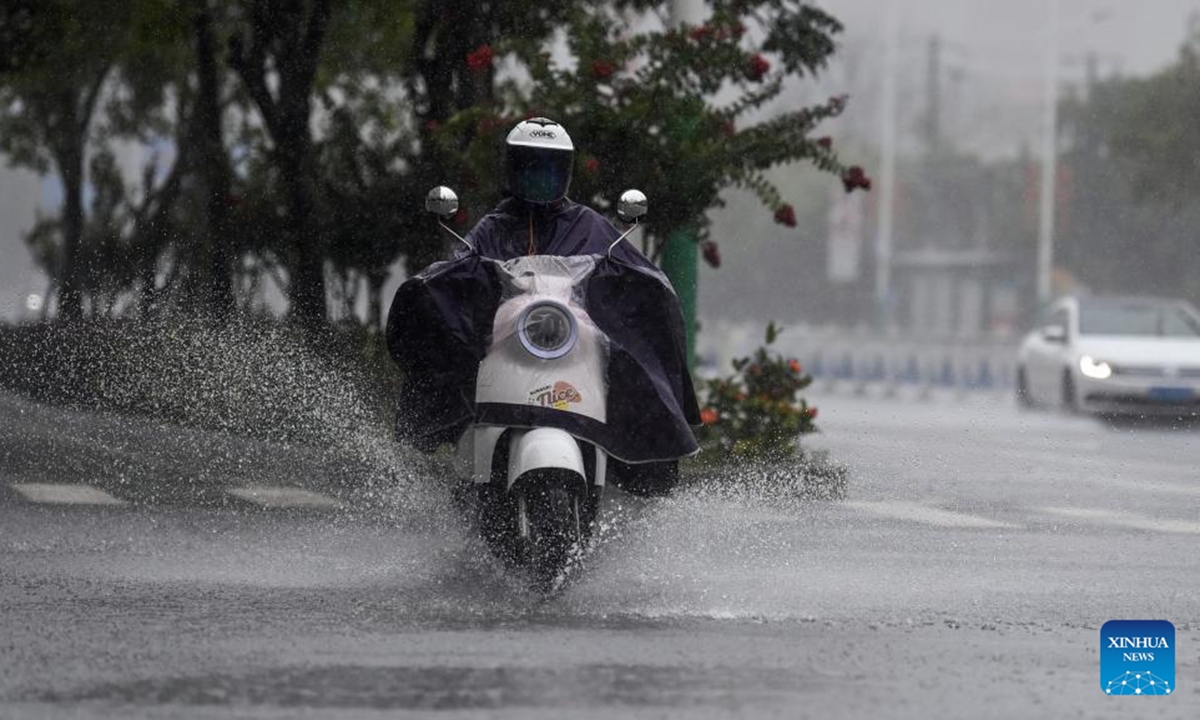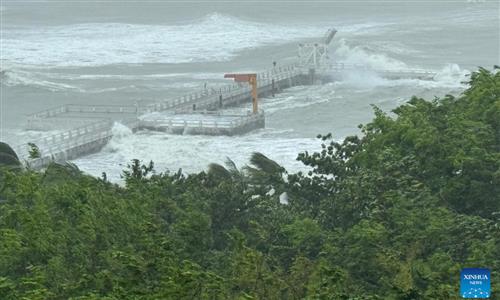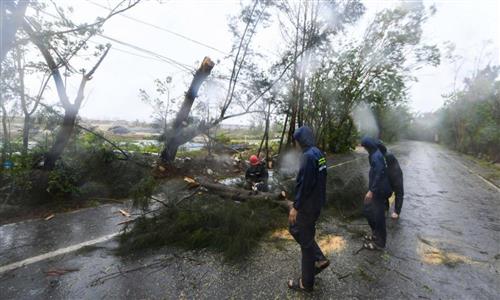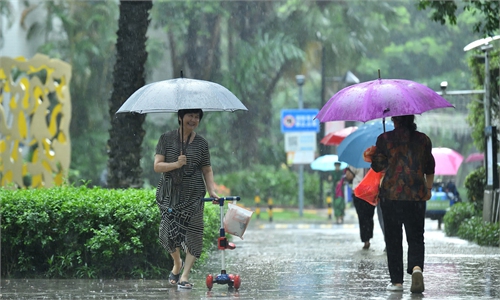
A citizen rides amid heavy rainfall in Beihai, South China's Guangxi Zhuang Autonomous Region on June 14, 2025. Multiple Chinese authorities convened on Saturday to put in place precautionary measures against Typhoon Wutip, the first typhoon of the year, which is expected to bring heavy rainfall to the southern parts of the country. Photo: Xinhua
Affected by a second landfall of this year's Typhoon Wutip along the western coast of Leizhou, South China's Guangdong Province, several cities in Guangdong renewed their rainstorm alerts on Sunday morning. A meteorological expert said that this typhoon formed late but made an early landfall, and its deep penetration inland after landing is unusual compared with normal years.Due to the heavy rain, a landslide killed three people in the neighboring Guangxi Zhuang Autonomous Region, reported China Central Television (CCTV) on Sunday.
According to the Guangdong provincial meteorological observatory, the center of the typhoon made landfall again in the western coastal area of Leizhou around 12:30 pm Saturday, packing maximum force 11 winds near its core, the Xinhua News Agency reported.
Guangdong's Yunfu meteorological observatory renewed a red alert for rainstorms, the most severe in its four-tier weather warning system, for multiple districts and towns in the city at 6:29 am on Sunday morning. Additionally, Shaoguan meteorological observatory renewed an orange alert for all subdistricts and towns in the Wujiang district and Zhenjiang district at 10:23 am.
A netizen surnamed Liao from the Yun'an district, Yunfu city, told the Global Times on Sunday that due to nearly eight hours of heavy rain the previous day, water accumulation in the district was relatively severe on Sunday.
"There were rescue teams going to the affected areas for disaster relief and lifeboats were dispatched," Liao noted. She added that the water began to recede at around 10 am on Sunday, and daily life has now basically returned to normal.
Another local resident surnamed An told the Global Times that the downtown area was less affected, while places near the lower reaches of rivers were more battered by the rainstorm. Public officials had been stationed at areas hard-hit by the rainstorm since the early hours of Saturday, An noted.
Despite the typhoon's low intensity, it carries a large amount of moisture and has penetrated deep inland, allowing it to maintain a warm-core structure for an extended period, resulting in more prolonged heavy rainfall, Ma Jun, director of the Beijing-based Institute of Public and Environmental Affairs, told the Global Times on Sunday.
At around 10 pm Saturday, the official Weibo account of Guangzhou emergency early warning information release center stated that a waterspout occurred south of the Humen Bridge between 2:36 pm and 3:00 pm Saturday, followed by another waterspout east of Longxue island between 3:00 pm and 3:30 pm, the Chinanews reported on Sunday.
No disaster reports have been received regarding these waterspouts, said the report.
Affected by the cloud system of the typhoon, heavy to torrential rains battered a large part of Yulin, South China's Guangxi Zhuang Autonomous Region from Saturday night to Sunday, state broadcaster CCTV reported.
Due to the heavy rain, a landslide occurred in Luchuan county in Yulin Saturday night, triggering a mudslide that affected nearby villages and left three people trapped, said the report. Local government organized rescue teams, firefighters and emergency forces to the scene.
As of around 8:40 am on Sunday, all three trapped individuals had been confirmed dead, per CCTV News.
In response to the rainstorms and flood disasters, China's Ministry of Finance and Ministry of Emergency Management has allocated 40 million yuan ($5.568 million) to South China's Hainan and Guangdong provinces, and Guangxi, Xinhua reported on Sunday.
The funds will be used for relocating and resettling affected personnel, emergency responses, investigations into secondary disaster risks and emergency remediation efforts, according to the report.
Wutip is moving from South China to Jiangnan (a region located in the coastal area south of the Yangtze River), with heavy rainstorms expected in some cities in East China's Jiangxi and Fujian provinces, as well as parts of the Yangtze River Delta cities, Ma said.
The expert noted that this year's first typhoon formed late, but made landfall early, and its deep penetration into inland after landing is different from previous years, adding that even if the typhoon is less intense, monitoring and early warning should not be slackened.



